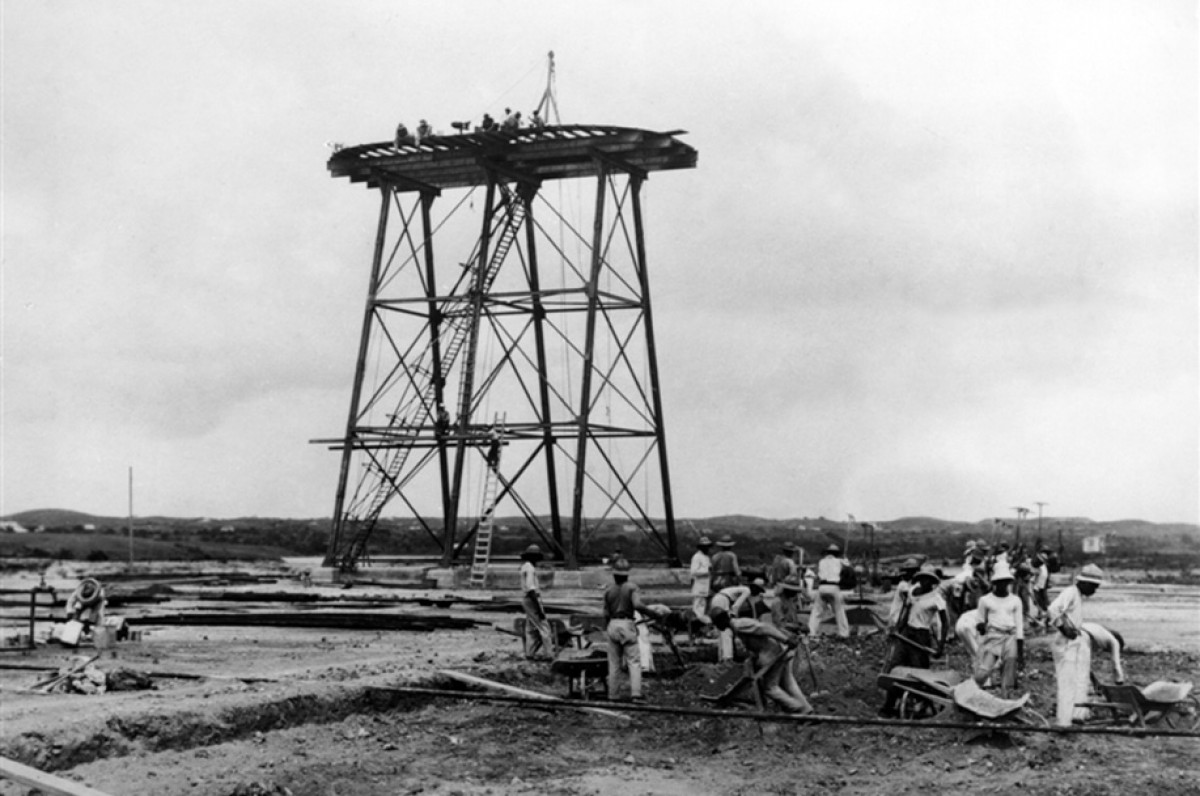In 1912 werd de Nederlands-Engelse onderneming Koninklijke Shell gevraagd te participeren in de exploratie van Venezolaanse olievelden. Shell-directeur Henri Deterding, die in een felle concurrentiestrijd verwikkeld was met het Amerikaanse oliebedrijf “Standard Oil Company of New Jersey”, besloot deel te nemen. Hij besloot voor Venezuela samen te werken met het Amerikaanse bedrijf “General Asphalt”, dat al actief was in Venezuela en de concessierechten daar bezat. Op 17 januari 1913 werd daarvoor de speciale investeringsmaatschappij, de Burlington Investment groep, opgericht. Binnen deze groep nam Shell de concessie- en exploitatierechten over van General Ashalt, terwijl die van Shell de middelen kreeg om de boringen ter hand te nemen. Een groep van zo’n 40 Amerikaanse geologen ging aan het werk in oostelijk Venezuela en het Maracaibo-gebied. Op 12 januari 1914 werd op Mene Grande een begin gemaakt met de boringen. De tweede put die ze sloegen leverde al een productie van 5.000 vaten per dag op. Deterding besloot daarop om een raffinaderij te bouwen en zijn oog viel op Curaçao. De natuurlijke haven en het stabiele bestuur gaven de doorslag boven de ondiepe haven van Maracaibo en het onrustige bestuur in Venezuela.
In eerste instantie had Deterding de mogelijkheid van een opslagplaats op Curaçao besproken. De lokale situatie op Curaçao was zo dat het handelshuis Maduro & Sons al sinds 1902 het agentschap had verworven van Shell’s concurrent, “Standard Oil”, maar niet veel kades bezat aan de Annabaai. De meeste kades waren in het bezit van de Curaçaose Handels Maatschappij (CHM). Om toch bunkerfaciliteiten aan de stoomschepen te kunnen aanbieden had Maduro aan CHM gevraagd om op hun kades opslagtanks voor Standard Oil producten te mogen bouwen. CHM wilde niet de producten van haar lokale concurrent Maduro op haar kades verkopen dus hadden ze aan Shell gevraagd om opslagtanks te bouwen voor Shell-producten. CHM zou dan tevens de lokale Shell agent kunnen worden. Deterding wilde niet mee gaan in deze lokale concurrentiestrijd. Hij wilde een raffinaderij bouwen op Curaçao en was niet meer geïnteresseerd in opslagtanks op de kades. Op 15 mei 1915 werd het besluit genomen een raffinaderij op Curacao te bouwen. Het beste terrein voor de raffinaderij was dat van Asiento. Op 30 augustus 1915 werd de 130 ha. grote plantage Asiento van H.H.R. Chapman gekocht voor 40.000 gulden. Het schiereiland Asiento werd overgenomen van CHM. Het was 25,15 ha. groot en werd voor 50.300 gulden gekocht. Van het Gouvernement werd het eilandje Negropont in het Schottegat in erfpacht verkregen. Er werden tevens enkele waterplantages gekocht (Valentijn) en putten geslagen op het terrein van Asiento om aan de geschatte dagelijkse behoefte van 100 tot 200 ton water te kunnen voldoen. De uiteindelijke bouw van de raffinaderij begon in 1918. Door de eerste wereldoorlog was het moeilijk om aan voldoende staal en scheepslading te komen.
Meer info:
Nationaal Archief Curacao of kijk ook even op de Canon van Curacao
Publicatie:
Olie als water - Van Soest
The arrival of the oil refinery in Curacao
In 1912, the Anglo-Dutch company Royal Dutch Shell was asked to participate in the exploration of Venezuelan oil fields. Shell director Henri Deterding, who was embroiled in a fierce competition with the American oil company "Standard Oil Company of New Jersey", decided to participate. He decided to merge operations with the small American company "General Asphalt" that was held in Venezuela and possessed the concession rights there. On January 17, 1913, the special investment company, the Burlington Investment Group was created; a cooperation between Shell and General Asphalt. Shell took over the concession- and operation rights from General Asphalt, while General Asphalt received the cash to begin the drilling. A group of about 40 American geologists went to work in the eastern Venezuela- and Maracaibo area. They started the process on January 12, 1914 with drilling at the Mene Grande site. Mene Grande produced an output of 5,000 barrels per day just on the second well. Deterding then decided to build a refinery near the well and his eye fell on Curaçao. The excellent harbor and stable government on Curacao were deciding factors compared to the shallow harbor of Maracaibo and notorious unstable government of Venezuela.
Initially Deterding had discussed the possibility of a storage facility in Curacao. The local situation in Curaçao was so that the trading company Maduro & Sons had acquired the agency for oil products of Shell's competitor, "Standard Oil", since 1902. The Maduro’s lacked the possession of sufficient quays at the Anna Bay. Most quays were in possession of the Curaçao Handels Maatschappij (CHM). To be able to offer bunker facilities to the steamships, Maduro had asked CHM to built bunker facilities on their quays. CHM did not want to sell the products of its local competitor Maduro on their quays, so they had asked Shell to build storage tanks and in the process would operate as their local agent. Deterding did not go along with this local competition. He wanted to build a refinery in Curacao and was no longer interested in tanks on the quays. On May 15, 1915 the decision was taken to build a refinery on Curacao. The best site for the refinery was the Asiento terrain. Shell bought the 130 hectares plantation of Asiento on August 30, 1915 from H.H.R. Chapman for 40,000 guilders. The Asiento peninsula belonged to the CHM. It measured 25.15 ha. and was bought for 50,300 guilders. The islet Negro Pont in “het Schottegat” was obtained from the Government as a long term lease. Some water plantations were also acquired (Valentine) and wells were drilled in the Asiento terrain to meet the estimated daily requirement of 100 to 200 tons of water. The final construction of the refinery started in 1918 by the end of the First World War. War time made it difficult to acquire enough steel and transshipment.
More info:
National ArchivesCuracao or Canon Curacao
Publication:
Olie als water - Van Soest
Deze tekst mag alleen worden overgenomen met vermelding van de bron: Nationaal Archief Curaçao.




